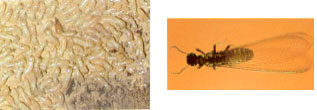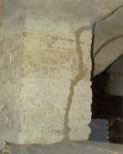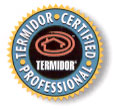Termidor
TERMITE SPECIES SERIES:
Eastern Subterranean Termite
Reticulitermes Flavipes (Kollar)
The Eastern Subterranean termite is the most common and most widely distributed termite in North America. It is a problem for homeowners from southern Ontario in Canada, south throughout the Eastern United States and as far west as Montana.
This native American pest feeds on such cellulose materials as structural wood, wood fixtures, paper, books, and cotton. Occasionally, it will even attack the roots of shrubs and trees.

A mature colony of Eastern Subterranean termites can range from a low of 20,000 to a high of 5 million workers, with an average of 300,000. The colony’s queen will add 5,000 to 10,000 eggs per year to the total.
While Eastern Sub termite colonies are not the largest termite colonies you can find, there will often be more than one of them working in a single building. Signs of Easterns include dirt-colored tubes built to serve as protected paths form the earth to the wood the termites are feeding on, and the translucent wings shed by the kings and queens during swarming. Swarming usually occurs in the spring, but other smaller swarms can occur throughout the summer and fall.
Some quick facts about Eastern Sub termites:
- On average, Eastern Sub termite colony can consume 5 grams of wood per day, the equivalent of 2 1/3 linear feet of a 2’x 4’ pine board annually.
- Colony growth is slow, and it may take years before swarmers are produced.
- Eastern Sub termites can enter buildings through cracks less than 1/64” wide.
- The termite colony is made up of different types (castes) of termites - each with seperate work responsibilites.
 Although Eastern Sub termite colonies are largely located in the ground below the frost line, secondary colonies can exist above ground, and examples of true above ground colonies existing without any ground contact have been seen. However, such above ground colonies have access to moisture and often the source is a roof or plumbing leak.
Although Eastern Sub termite colonies are largely located in the ground below the frost line, secondary colonies can exist above ground, and examples of true above ground colonies existing without any ground contact have been seen. However, such above ground colonies have access to moisture and often the source is a roof or plumbing leak.- Eastern Sub termites will often build mud tubes for travel between their colonies and their food source.
- The king and queen in a colony can live for 10 to 30 years, while workers live for about two years.
Whatever the species, Termidor® Termiticide/Insecticide is your answer
Fortunately, there is a solution to termite problems like those posed by Eastern Sub termites: It’s Termidor.
Tests have shown that Termidor to be 100% effective against subterranean termites, even in the most challenging situations.
Termidor is nonrepellant
If a termiticide is nonrepellent, that means the termites can’t see it, smell it, or feel it. In fact, they don’t even know it’s there at all. As a result, they’ll continue to forage in treated areas. That might alarm you, but it’s a good thing. Termites that are active in areas that have been treated with Termidor are helping to spread Termidor to more termites; they are, in fact, helping the termiticide do its job. Rest assured that in a short time all the termites - those you see and those you don’t - will be controlled.
Remember, Termidor kills in two ways:
First, Termidor, kills termites when they eat it (and since they don’t know it’s there, they readily ingest it along with the wood fiber and other material they typically eat). Second, Termidor kills termites that simply come into contact with it. So, even if your termites are not feeding, Termidor will kill them.
Termites that come into contact with Termidor will also carry it on their bodies. As a result, every other termite they contact, feed, or groom will also be exposed to Termidor. All these termites will in turn transfer the termiticide to still more termites. This will go on for several days, allowing Termidor to be spread throughout the entire colony. This unique mode of action is known as the “Transfer Effect”.
The active ingredient in Termidor, fipronil, is slow acting. That’s a very good thing for you, and a very bad thing for the Eastern Sub termite colony. Why? Because Termidor remains active long enough for one termite to transfer the termiticide to a large number of other termites in the colony before dying itself. And although Termidor’s effect on individual termites is intentionally slow, the overall impact on the colony is fast.
 What to expect after application
What to expect after application
Certainly, every home is different, so the specifics of your Termidor treatment and results will depend on your home’s age, configuration, construction, and level of infestation. Your Termidor Certified Professional will explain the best procedure for your situation. The entire application program is typically complete in a day or less; however, you may see some evidence of termite activity for several days afterward. That’s okay. Rest assured that Termidor is working, and its unique ingestion, contact, and “Transfer Effect” will eliminate termites from your home. Remember, responsible termite control demands periodic inspections by a licensed pest management professional.